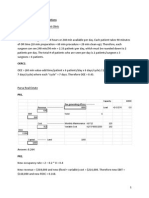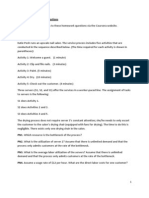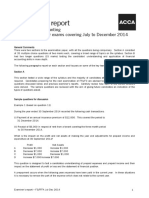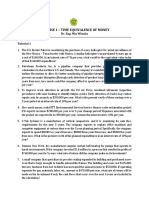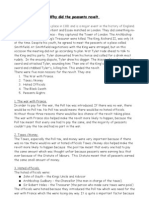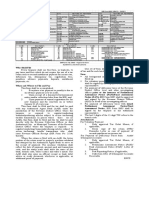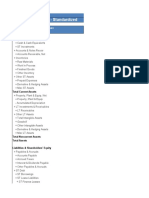Homework #3 - Coursera Corrected
Homework #3 - Coursera Corrected
Uploaded by
SaravindCopyright:
Available Formats
Homework #3 - Coursera Corrected
Homework #3 - Coursera Corrected
Uploaded by
SaravindOriginal Title
Copyright
Available Formats
Share this document
Did you find this document useful?
Is this content inappropriate?
Copyright:
Available Formats
Homework #3 - Coursera Corrected
Homework #3 - Coursera Corrected
Uploaded by
SaravindCopyright:
Available Formats
5/9/2016
Homework#3|Coursera
Homework #3
5/10 points earned (50%)
You haven't passed yet. You need at least70% to pass.
Review the material and try again! You have 3 attempts
every a day.
Review Related Lesson (/learn/wharton-accounting/home/week/3)
0/1
points
1.
Which of the following would be a cash ow from operating activities?
(check all that apply)
Purchases of equipment
Correct Response
Purchases of equipment are an investing cash ow.
Collections from customers
Incorrect Response
Operating cash ow.
Loss on sale of equipment
Incorrect Response
Loss on sale of equipment is a cash ow from investing
activities.
https://www.coursera.org/learn/whartonaccounting/exam/EJ7aB/homework3
1/10
5/9/2016
Homework#3|Coursera
Amortization of a patent
Incorrect Response
Amortization of a patent is a noncash transaction, so it would
not be a cash ow.
Payments for salaries and wages
Correct Response
Operating cash ow.
0/1
points
2.
Which of the following would be a cash ow from nancing activities?
(check all that apply)
Payments to suppliers
Correct Response
Payments to suppliers are operating cash ows.
Payments to acquire a company
Incorrect Response
Payments to acquire a company are investing cash ows.
Proceeds from issuing stock
Correct Response
Cash ow from nancing activities.
Proceeds from selling equipment
Incorrect Response
Proceeds from selling equipment are investing cash ows.
https://www.coursera.org/learn/whartonaccounting/exam/EJ7aB/homework3
2/10
5/9/2016
Homework#3|Coursera
Repayments of principal portion of debt
Correct Response
Cash ow from nancing activities.
1/1
points
3.
A company has the following cash ows:
Cash from operations 10
Cash from investing activities (1)
Cash from nancing activities (9)
Which growth stage best describes this pattern of cash ows?
Decline
Correct Response
This pattern is typical for a company in decline. The company
still has a positive cash from operations, but is investing very
little in long-term assets, indicating that it doesn't have many
new opportunities. The company uses its excess free cash ow
to pay dividends, pay down debt, or buy back equity, which
leads to a negative nancing cash ow.
Early growth
Stable
Perky
Start-up
1/1
https://www.coursera.org/learn/whartonaccounting/exam/EJ7aB/homework3
3/10
5/9/2016
Homework#3|Coursera
points
4.
A company bought $50,000 of inventory for $20,000 cash, with the
balance due to the supplier in 30 days. What is the operating cash ow
in this transaction?
$0
($50,000)
($20,000)
Correct Response
You can think of this as two transactions. First, the company
bought $20,000 of inventory with cash. This is an operating
cash ow. Second, the company bought $30,000 of inventory
on account. This is a non-cash transaction. So, the operating
cash ow is ($20,000).
($70,000)
($30,000)
0/1
points
5.
Which of the following would be shown as a negative number in the
Operating section of the SCF under the indirect method? (check all that
apply)
Capital expenditures
Incorrect Response
Capital expenditures are an investing activity.
Decrease in Accounts Receivable
Incorrect Response
https://www.coursera.org/learn/whartonaccounting/exam/EJ7aB/homework3
4/10
5/9/2016
Homework#3|Coursera
A decrease in Accounts Receivable would be added back
(decrease in a noncash asset = increase in cash on the balance
sheet equation).
Decrease in Accounts Payable
Correct Response
A decrease in Accounts Payable would be subtracted (decrease
in liability = decrease in cash on the balance sheet equation).
Depreciation on a building
Incorrect Response
Depreciation is added back to Net Income under the indirect
method, so it would be a positive number.
Gain on sale of equipment
Correct Response
Gain on sale of equipment would be subtracted from Net
Income under the indirect method (it increased net income but
must be subtracted out because it is not operating, but
investing).
0/1
points
6.
A company has Net Income of $10, which included $2 of depreciation
expense. There were no other noncash expenses in Net Income and
there were no gains or losses. Accounts receivable was $20 at the
beginning of the year and $25 at the end of the year. Accounts Payable
was $15 at the beginning of the year and $5 at the end of the year.
Inventory was $12 at the beginning of the year and $7 at the end of the
year. All other balance sheet accounts were unchanged over the year.
What was the companys Cash Flow from Operating Activities?
$7
https://www.coursera.org/learn/whartonaccounting/exam/EJ7aB/homework3
5/10
5/9/2016
Homework#3|Coursera
$2
$12
($2)
Incorrect Response
Lets do the indirect method! Start with Net Income of $10. Add
back $2 of Depreciation Expense. Subtract the increase in A/R
of $5. Subtract the decrease in A/P of $10. Add the decrease in
Inventory of $5. The answer is $10 + $2 $5 $10 + $5 = $2.
$22
1/1
points
7.
A company put together a preliminary version of its nancial
statements. Its Net Income was $300, its Depreciation Expense was
$80, and its Cash Flow from Operations was $190. The accountant
found an error in computing straight-line Depreciation Expense. It
should have been $70. What is Cash from Operations after xing this
mistake? (you can ignore taxes)
$190
Correct Response
Net Income would increase by $10 with the smaller expense.
The amount of depreciation expense added back would go
down by $10. These would cancel each other out and there
would be no eect on Cash from Operations. So, Cash from
Operations would remain at $190.
$200
$180
$370
$0
https://www.coursera.org/learn/whartonaccounting/exam/EJ7aB/homework3
6/10
5/9/2016
Homework#3|Coursera
1/1
points
8.
A company sold PP&E for $200 cash. Prior to the sale, the net book
value of the PP&E on the nancial statements was $240. Thus, the
company recorded a Loss on Sale of Equipment of $40 in Net Income.
What is the operating cash ow in this transaction?
$160
$40
$200
$0
Correct Response
The answer is zero! The entire $200 cash is an investing cash
ow. The loss will be added back in the operating section, but
that is merely to avoid double counting, since the loss also
shows up in Net Income (i.e., the loss reduced Net Income by
$40, then we added back $40 in the operating section to get to
no eect on operating cash ows).
$240
0/1
points
9.
During the year, a company sold $500 of inventory, paid $400 to
suppliers for inventory previously purchased on account, purchased
$100 of inventory for cash, acquired $75 of inventory from another
company in an acquisition, and translated into US dollars the value of
inventory held in foreign subsidiaries, which increased inventory by
$25. Which of these Inventory transactions would show up in the
operating section of the SCF? (check all that apply)
Acquired $75 of inventory from another company in an
acquisition
https://www.coursera.org/learn/whartonaccounting/exam/EJ7aB/homework3
7/10
5/9/2016
Homework#3|Coursera
Correct Response
Acquisitions and foreign currency adjustments were two
reasons given in the video for why a number on the SCF might
not match the change on the Balance Sheet. Thus, those two
transactions will not appear in the operating section. In the
other cases, the sale or purchase of Inventory, or payments to
suppliers, will show up in the operating section.
Paid $400 to suppliers for inventory previously purchased on
account
Correct Response
Acquisitions and foreign currency adjustments were two
reasons given in the video for why a number on the SCF might
not match the change on the Balance Sheet. Thus, those two
transactions will not appear in the operating section. In the
other cases, the sale or purchase of Inventory, or payments to
suppliers, will show up in the operating section.
Sold $500 of inventory
Incorrect Response
Acquisitions and foreign currency adjustments were two
reasons given in the video for why a number on the SCF might
not match the change on the Balance Sheet. Thus, those two
transactions will not appear in the operating section. In the
other cases, the sale or purchase of Inventory, or payments to
suppliers, will show up in the operating section.
The value of inventory held in foreign subsidiaries increased
by $25 when translated into US dollars
Correct Response
Acquisitions and foreign currency adjustments were two
reasons given in the video for why a number on the SCF might
not match the change on the Balance Sheet. Thus, those two
transactions will not appear in the operating section. In the
other cases, the sale or purchase of Inventory, or payments to
suppliers, will show up in the operating section.
https://www.coursera.org/learn/whartonaccounting/exam/EJ7aB/homework3
8/10
5/9/2016
Homework#3|Coursera
Purchased $100 of inventory for cash
Incorrect Response
Acquisitions and foreign currency adjustments were two
reasons given in the video for why a number on the SCF might
not match the change on the Balance Sheet. Thus, those two
transactions will not appear in the operating section. In the
other cases, the sale or purchase of Inventory, or payments to
suppliers, will show up in the operating section.
1/1
points
10.
A company had EBITDA of $1000, Depreciation and Amortization
Expense of $100, Interest Expense of $100, and Tax Expense of $50.
What was the companys Net Income?
$950
$1250
$1000
$750
Correct Response
EBITDA = Net Income (or Earnings) + Depreciation and
Amortization Expense + Interest Expense + Tax Expense. Thus,
$1000 = Net Income + $100 + $100 + $50 => Net Income =
$1000 $250 = $750.
($750)
https://www.coursera.org/learn/whartonaccounting/exam/EJ7aB/homework3
9/10
5/9/2016
Homework#3|Coursera
https://www.coursera.org/learn/whartonaccounting/exam/EJ7aB/homework3
10/10
You might also like
- Homework Assignment Module 2 - Process AnalysisDocument7 pagesHomework Assignment Module 2 - Process AnalysisRodrigo Isaac100% (3)
- Certification Exam: Review: Wall Street PrepDocument21 pagesCertification Exam: Review: Wall Street Prepduc anh100% (1)
- Final Exam Solutions UPLOADEDDocument9 pagesFinal Exam Solutions UPLOADEDyashar250085% (26)
- Module 2 HW SolutionsDocument2 pagesModule 2 HW Solutionswhatecer88% (16)
- Coursera Operation Management Final Exam Questions - Module 2Document4 pagesCoursera Operation Management Final Exam Questions - Module 2Xiaoyi Wang12% (25)
- L1 - JN - Financial Statement Analysis 2024 V1Document66 pagesL1 - JN - Financial Statement Analysis 2024 V1niketshah75oNo ratings yet
- Homework Assignment: Module 2 - Process Analysis: Posh NailsDocument49 pagesHomework Assignment: Module 2 - Process Analysis: Posh NailsIisha karmela Alday100% (6)
- Financial Analysis Complete Guide 1718764711Document66 pagesFinancial Analysis Complete Guide 1718764711dqk2tqvpnhNo ratings yet
- Homework #2 - CourseraDocument8 pagesHomework #2 - Courserainbarexy67% (6)
- Module 3 HW SolutionsDocument2 pagesModule 3 HW Solutionsabishakekoul70% (23)
- Quiz 1 Financial StatementDocument8 pagesQuiz 1 Financial StatementErvAnTjAhJaCkNo ratings yet
- Valley Forge Problem SoutionDocument5 pagesValley Forge Problem SoutionSashi Velnati0% (1)
- Handout: Course Code and Name: Unit Code: Unit TitleDocument10 pagesHandout: Course Code and Name: Unit Code: Unit TitleGabriel ZuanettiNo ratings yet
- Final Mock ExamDocument16 pagesFinal Mock Examsalome75% (4)
- NYU Final2Document12 pagesNYU Final2HE HUNo ratings yet
- Homework #3 - Coursera32 PDFDocument9 pagesHomework #3 - Coursera32 PDFAnurag SahrawatNo ratings yet
- G10488 EC - Core 1 SAEE Solution PDFDocument127 pagesG10488 EC - Core 1 SAEE Solution PDFsamit shresthaNo ratings yet
- Part 2 - Liquidity and Profitability Ratios (Exercises) - Sol 11 Sept 2021Document66 pagesPart 2 - Liquidity and Profitability Ratios (Exercises) - Sol 11 Sept 2021Alyssa PilapilNo ratings yet
- Intro To Financial Accounting CourseraDocument10 pagesIntro To Financial Accounting CourseraSirius BlackNo ratings yet
- Introduction To Operations ManagementsDocument3 pagesIntroduction To Operations Managementsmpeart1012% (17)
- An Introduction To Operations ManagementDocument3 pagesAn Introduction To Operations Managementjpgutierrez110% (1)
- Final Exam Module 2Document17 pagesFinal Exam Module 2Rodrigo Isaac17% (6)
- Wek 5 HomeworkDocument5 pagesWek 5 HomeworkJobarteh FofanaNo ratings yet
- Financial Performance Metrics - Financial RatiosDocument98 pagesFinancial Performance Metrics - Financial RatiosAjmal SalamNo ratings yet
- Jaffee & Stiglitz, Credit RationingDocument52 pagesJaffee & Stiglitz, Credit RationingAnonymous ykRTOE100% (1)
- TestDocument8 pagesTestVimal GuptaNo ratings yet
- Week 2 - 1Document8 pagesWeek 2 - 1Bala MuruganNo ratings yet
- Quiz Feedback - Coursera Week 4 Intro To FinanceDocument7 pagesQuiz Feedback - Coursera Week 4 Intro To FinanceVictoriaLukyanova0% (1)
- 2week v2Document10 pages2week v2Sirius BlackNo ratings yet
- Module 4 HW QuestionsDocument2 pagesModule 4 HW Questionswhatecer19% (16)
- Module 3 HW SolnDocument2 pagesModule 3 HW SolnKlausMalheiros100% (4)
- Homework Module 4-QualityDocument3 pagesHomework Module 4-QualityTamahqua Tankamochkhanna HunterHoggsirls0% (20)
- Module 5 HW Questions UPLOADED PDFDocument2 pagesModule 5 HW Questions UPLOADED PDFgleisonguimaraes0% (2)
- Wharton Business Foundations Intro To FiDocument4 pagesWharton Business Foundations Intro To FiGeetNo ratings yet
- Final Exam Questions - Module 3Document3 pagesFinal Exam Questions - Module 3whatecer11% (9)
- Module 5 HW Questions UploadedDocument2 pagesModule 5 HW Questions Uploadedapi-1839155060% (4)
- 2 WeekDocument9 pages2 WeekSirius BlackNo ratings yet
- Ffa12efmq A Low ResDocument34 pagesFfa12efmq A Low ResAdi StănescuNo ratings yet
- D23 FM Examiner's ReportDocument20 pagesD23 FM Examiner's ReportEshal KhanNo ratings yet
- Acca F7 Financial Reporting (INT) June 2015: Sample NoteDocument64 pagesAcca F7 Financial Reporting (INT) June 2015: Sample NoteAna-Maria ZampaNo ratings yet
- Dec2015 F3.Exam ReportDocument4 pagesDec2015 F3.Exam ReportVoTrieuAnhNo ratings yet
- F3.ffa Examreport d14Document4 pagesF3.ffa Examreport d14Kian TuckNo ratings yet
- ACC 305 Complete Course FilesDocument16 pagesACC 305 Complete Course FileshomeworkbagsNo ratings yet
- Part 2 Liquidity and Profitability Ratios - Sol 13 Jan 2024Document72 pagesPart 2 Liquidity and Profitability Ratios - Sol 13 Jan 2024Ayame KusuragiNo ratings yet
- CH 14 QuizDocument6 pagesCH 14 Quizpjama2012No ratings yet
- Exam PaperDocument4 pagesExam PaperSonam Dema DorjiNo ratings yet
- 02 - Advanced Accounting R 2009Document10 pages02 - Advanced Accounting R 2009jhouvanNo ratings yet
- Part 2 Special Issues ForEx Fluctuations, Inflation, Acctng Changes, Econ Profit, Earnings Quality - Sol 14 Jan 2024Document66 pagesPart 2 Special Issues ForEx Fluctuations, Inflation, Acctng Changes, Econ Profit, Earnings Quality - Sol 14 Jan 2024Ayame KusuragiNo ratings yet
- Practice Technicals 3Document6 pagesPractice Technicals 3tigerNo ratings yet
- Acc 290 Acc290 PDFDocument46 pagesAcc 290 Acc290 PDFCourse HelpNo ratings yet
- Chapter 2 Financial Statements and Accounting Concepts and PrinciplesDocument57 pagesChapter 2 Financial Statements and Accounting Concepts and Principlesbrendon laverNo ratings yet
- Revised BDM - Sample Q&A SolveDocument13 pagesRevised BDM - Sample Q&A SolveSonam Dema DorjiNo ratings yet
- Financial Accounting Exam (Page 2 of 7)Document5 pagesFinancial Accounting Exam (Page 2 of 7)hassanmarzouk44No ratings yet
- Homework w2Document7 pagesHomework w2ergjnv85100% (2)
- Acca Simple Cosolidation TacniquesDocument11 pagesAcca Simple Cosolidation TacniquesNajam HudaNo ratings yet
- Examiner's Report: F3/FFA Financial Accounting June 2012Document4 pagesExaminer's Report: F3/FFA Financial Accounting June 2012Ahmad Hafid HanifahNo ratings yet
- CourseHeroExam1 1Document8 pagesCourseHeroExam1 1David LewisNo ratings yet
- Chp 14 Capital and revenue expendituresDocument27 pagesChp 14 Capital and revenue expenditurest.zeeshanNo ratings yet
- Ffa Dec 2016Document4 pagesFfa Dec 2016siti navillahNo ratings yet
- Financial Accounting Exam (Page 7 of 7)Document5 pagesFinancial Accounting Exam (Page 7 of 7)hassanmarzouk44No ratings yet
- Analysis SumsDocument11 pagesAnalysis SumsJessy NairNo ratings yet
- CM341.SCM (AL-I) Question CMA May-2023 Exam.Document5 pagesCM341.SCM (AL-I) Question CMA May-2023 Exam.MasumHasanNo ratings yet
- ACCT504 Case Study 1 The Complete Accounting Cycle-13Document16 pagesACCT504 Case Study 1 The Complete Accounting Cycle-13chaitrasuhas0% (1)
- Duty On Documents and Transfers Rules: Subsidiary Legislation 364.06Document26 pagesDuty On Documents and Transfers Rules: Subsidiary Legislation 364.06Amadeus CachiaNo ratings yet
- CPA 1 - Financial AccountingDocument8 pagesCPA 1 - Financial AccountingPurity muchobella100% (1)
- Lesson 2 Tax Accounting PrinciplesDocument39 pagesLesson 2 Tax Accounting PrinciplesakpanyapNo ratings yet
- PSO Shell Report - Financial ManagementDocument7 pagesPSO Shell Report - Financial ManagementChaudhary Hassan ArainNo ratings yet
- Pilipinas Total Gas v. CIRDocument4 pagesPilipinas Total Gas v. CIRDanJalbunaNo ratings yet
- Teresita Buenaflor ShoesDocument1 pageTeresita Buenaflor ShoesmonomagicshopNo ratings yet
- Exercise 1 - TVM & Equivalence 2.0Document5 pagesExercise 1 - TVM & Equivalence 2.0Bayu PurnamaNo ratings yet
- Multiple Choice Questions:: University of Makati Midterm Examination Taxation January 28, 2019Document4 pagesMultiple Choice Questions:: University of Makati Midterm Examination Taxation January 28, 2019Angeline EspelaNo ratings yet
- Why Did The Peasants Revolt History EssayDocument2 pagesWhy Did The Peasants Revolt History EssayEvan Bailey50% (2)
- Analysis and Interpretation of Financial StatementsDocument27 pagesAnalysis and Interpretation of Financial StatementsRajesh PatilNo ratings yet
- For Sir Red - 20 MCQs - TAXATIONDocument5 pagesFor Sir Red - 20 MCQs - TAXATIONRed Christian PalustreNo ratings yet
- PROJECT On Cost Accounting Final - Commerce +2 ND YrsDocument15 pagesPROJECT On Cost Accounting Final - Commerce +2 ND Yrspurnima.aind.253No ratings yet
- CIR v. Central Luzon Drug CorpDocument2 pagesCIR v. Central Luzon Drug CorpSophia SyNo ratings yet
- Annual Report 2005-06 - Kingfisher AirlinesDocument68 pagesAnnual Report 2005-06 - Kingfisher AirlinesAparna NandananNo ratings yet
- Mod 2 - Problems - Cost SheetDocument14 pagesMod 2 - Problems - Cost Sheetzach thomasNo ratings yet
- CH 10Document47 pagesCH 10maschip313No ratings yet
- Slovakia NPRR enDocument174 pagesSlovakia NPRR enOxana PaiereleNo ratings yet
- DDDocument4 pagesDDAmelia Salini100% (1)
- D&L Industries: Investor PresentationDocument44 pagesD&L Industries: Investor PresentationGiang NguyenNo ratings yet
- As 6 Depreciation AccountingDocument5 pagesAs 6 Depreciation AccountingJagmohanKiruthivasanKameswariNo ratings yet
- Presented by "GROUP 5": G R O U PDocument8 pagesPresented by "GROUP 5": G R O U PMV RahulNo ratings yet
- Who Shall File: ATC Natur E of P Ayment ATC Natureof Payment ATC Na Ture of P A YmentDocument1 pageWho Shall File: ATC Natur E of P Ayment ATC Natureof Payment ATC Na Ture of P A Yment잔돈No ratings yet
- Aviva PLC Annual Report and Accounts 2013Document320 pagesAviva PLC Annual Report and Accounts 2013Aviva GroupNo ratings yet
- Tesla Motors IncDocument18 pagesTesla Motors IncSantiago Prada CruzNo ratings yet
- Dadra and Nagar Haveli Bonus Notification 2019Document2 pagesDadra and Nagar Haveli Bonus Notification 2019Manish ShahNo ratings yet
- Notes To Financial StatementsDocument4 pagesNotes To Financial StatementsKendrew SujideNo ratings yet









